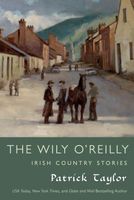 Series: Irish Country (Book 9)
Series: Irish Country (Book 9)
Long before Dr. Fingal Flahertie O’Reilly made most readers’ acquaintance in Patrick Taylor’s bestselling novel An Irish Country Doctor, he appeared in a series of humorous columns originally published in Stitches: The Journal of Medical Humour. These warm and wryly amusing vignettes provide an early glimpse at the redoubtable Dr. O’Reilly as he tends to the colourful and eccentric residents of Ballybucklebo, a cozy Ulster village nestled in the bygone years of the early sixties.
Those seminal columns have been collected in The Wily O’Reilly: Irish Country Stories. In this convenient volume, Patrick Taylor’s legions of devoted fans can savor the enchanting origins of the Irish Country series . . . and newcomers to Ballybucklebo can meet O’Reilly for the very first time.
An ex-Navy boxing champion, classical scholar, crypto-philanthropist, widower, and hard-working general practitioner, Fingal Flahertie O’Reilly is crafty and cantankerous in these charming slices of rural Irish life. Whether he’s educating a naive man of the cloth in the facts of life, dealing with chronic hypochondriacs and malingerers, clashing with pigheaded colleagues, or raising a pint in the neighborhood pub, the wily O’Reilly knows a doctor’s work is never done, even if some of his “cures” can’t be found in any medical text!
I love the Irish Country series and have been reading the books since their beginning in 2007. I have lost count of the number of times I have laughed until I've cried. It was intriguing to read at the beginning of this book of how the novels came to be. Each chapter is about three or four pages long and is made up of one of Dr. Taylor's columns from the Canadian medical magazine Stitches: The Journal of Medical Humour. They are chronological, and it is easy to see the development of the author's writing style.
In these stories, Dr. O'Reilly's assistant is the author himself, rather than the Dr. Laverty we come to know in the series. Each one shows Dr. O'Reilly in his role as doctor, mentor, friend, and occasionally the hand of justice. In some stories, there are the seeds that come into full flower in the novels, where the situations and characters are further developed. Some of the characters have undergone significant changes between the columns and the books, most notably (in my opinion) Donal Donnelly. In the columns, he is rather simple and not overly bright, while in the novels he has a unique cleverness that gets him into and out of all kinds of trouble.
I thoroughly enjoyed the early looks at Bertie Bishop, Kinky the housekeeper, and other residents of Ballbucklebo. The heart of the small village is the same, from columns to novels. This Dr. O'Reilly is a bit more rough around the edges, but the essence of him is the same. I loved seeing his ease and kindness with the children, even those that tried his patience, such as his nephew, Willy. I laughed out loud at the two little ones who came to him for pre-marital counseling, and again at Willy's portrayal of the innkeeper during the Christmas play.
The wily Dr. O'Reilly had many opportunities to demonstrate to young Dr. Taylor that not all cures came out of a bottle. Some of the best stories came from just knowing your patient and understanding where they were coming from. I especially loved his encounters with Miss Maggie MacCorkle and how he never made her feel foolish. He also did not suffer fools gladly, and there were several occasions where he found interesting ways to deliver rough justice to those who offended him.
There were several stories that would have been right at home in James Herriot's All Creatures books. There were a couple of amusing stories involving pigs, the doctor's least favorite animal. My favorites were those involving his cat, Lady Macbeth, and his black lab, Arthur Guinness. The best were the two stories where first, Dr. O'Reilly decided that taking Lady Macbeth out on his boat was an excellent idea. It did not end well, for either the boat or the doctor. The subsequent trip, with Arthur, was equally hilarious.
The book finished with a short story "Home is the Sailor" about O'Reilly's return to Ballbucklebo after being away at war for six years. It is the beginning of his career as village's doctor, full of his fears about whether he can make a go of it. The maturing of the author's characterizations is clear, and I loved O'Reilly's encounters with his early patients.

No comments:
Post a Comment